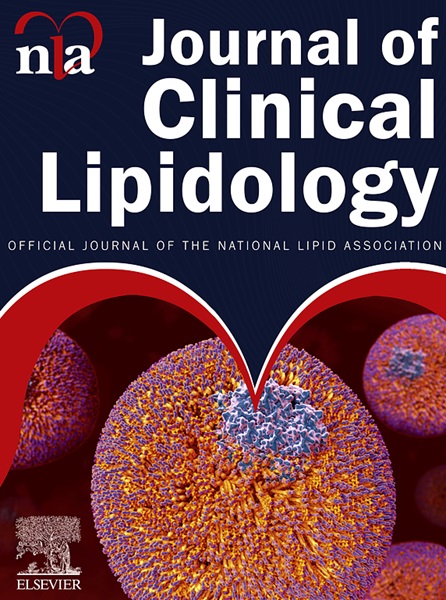FIND-FH机器学习算法用于识别可疑家族性高胆固醇血症个体的性能。
IF 4.6
3区 医学
Q2 PHARMACOLOGY & PHARMACY
引用次数: 0
摘要
背景:家族性高胆固醇血症(FH)是一种明显未被诊断的遗传性胆固醇疾病。目的:本研究评估了Find -FH评分(一种新型机器学习算法)在识别高可能性FH个体方面的现实表现。方法:将FIND-FH模型应用于UT西南医学中心的电子健康记录(EHR)数据。对被认为是FH高概率(评分>0.35)的患者进行人工图表复习,以评估FH诊断的准确性,采用改进的Simon-Broome和荷兰脂质临床网络(DLCN)标准。个体特征在FIND-FH评分的五分位数之间进行比较。使用预先确定的临床标准确定适合FH外展的个体,表示FH的临床概率足够。结果:在EHR数据集中的93418个个体中,FIND-FH算法识别出340个高概率FH。这340人的平均年龄为49.8岁,男性占59%,低密度脂蛋白胆固醇(LDL-C)最高为168.4 mg/dL(±51.9)。根据现有的电子病历数据,总共有20-32%的患者符合至少可能的跳频的修改Simon-Broome或DLCN标准。一些变量在FIND-FH评分五分位数上存在显著差异,包括Simone-Broome和DLCN概率。在回顾的队列中,191例(56%)有足够的临床怀疑FH,需要进行外诊。结论:在一个大型医疗系统EHR队列中,大多数通过FIND-FH算法确定为FH高风险的个体被认为适合进一步评估,尽管大多数不符合FH诊断标准使用现有的EHR数据。本文章由计算机程序翻译,如有差异,请以英文原文为准。
Performance of the FIND-FH machine learning algorithm for the identification of individuals with suspected familial hypercholesterolemia
BACKGROUND
Familial hypercholesterolemia (FH) is an inherited cholesterol disorder that is markedly underdiagnosed.
OBJECTIVE
This study evaluated the real-world performance of the Find, Identify, Network, Deliver-FH (FIND-FH) score, a novel machine learning algorithm, in identifying individuals with high likelihood of FH.
METHODS
The FIND-FH model was applied to electronic health record (EHR) data from UT Southwestern Medical Center. Manual chart review was performed on those deemed high probability of FH (score >0.35) to assess accuracy of FH diagnosis by modified Simon-Broome and Dutch Lipid Clinic Network (DLCN) criteria. Individual characteristics were compared across quintiles of the FIND-FH score. Individuals deemed suitable for FH outreach were identified using predetermined clinical criteria denoting adequate clinical probability of FH.
RESULTS
Of the 93,418 individuals in the EHR dataset, the FIND-FH algorithm identified 340 with high probability of FH. These 340 individuals had a mean age of 49.8 years, were 59% male, and had a highest low-density lipoprotein cholesterol (LDL-C) of 168.4 mg/dL (±51.9). A total of 20-32% met modified Simon-Broome or DLCN criteria for at least possible FH based on available EHR data. Several variables differed significantly by FIND-FH score quintile, including Simone-Broome and DLCN probability. In the reviewed cohort, 191 (56%) had enough clinical suspicion for FH to warrant outreach. Among these, 101 (53%) had highest LDL-C <190 mg/dL and would be missed by LDL-C-based FH screening strategies.
CONCLUSION
In a large healthcare system EHR cohort, most individuals identified as higher risk for FH by the FIND-FH algorithm were deemed appropriate for further evaluation, despite the majority not meeting FH diagnostic criteria using available EHR data.
求助全文
通过发布文献求助,成功后即可免费获取论文全文。
去求助
来源期刊
CiteScore
7.00
自引率
6.80%
发文量
209
审稿时长
49 days
期刊介绍:
Because the scope of clinical lipidology is broad, the topics addressed by the Journal are equally diverse. Typical articles explore lipidology as it is practiced in the treatment setting, recent developments in pharmacological research, reports of treatment and trials, case studies, the impact of lifestyle modification, and similar academic material of interest to the practitioner.
Sections of Journal of clinical lipidology will address pioneering studies and the clinicians who conduct them, case studies, ethical standards and conduct, professional guidance such as ATP and NCEP, editorial commentary, letters from readers, National Lipid Association (NLA) news and upcoming event information, as well as abstracts from the NLA annual scientific sessions and the scientific forums held by its chapters, when appropriate.

 求助内容:
求助内容: 应助结果提醒方式:
应助结果提醒方式:


